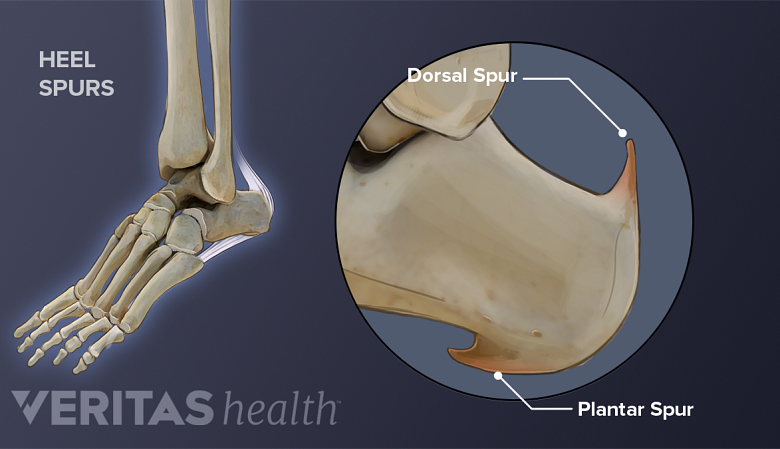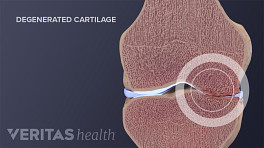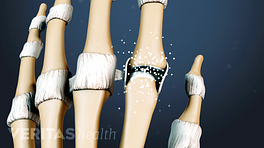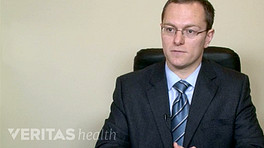Ankle arthritis may cause pain, stiffness, and swelling, especially after walking or exercise. Arthritis often develops in an ankle that was sprained or broken in the past, so arthritis symptoms are sometimes mistaken for an old injury "acting up."
When the cartilage of the ankle becomes damaged, bone changes such as heel spurs may occur.
The defining feature of osteoarthritis is the breakdown of articular cartilage. This type of cartilage normally covers and protects the surfaces of bones where they meet at the joints. In the ankle, a thin layer of articular cartilage covers the bottom of the shin’s tibia and fibula bones and the top of the foot’s talus bone.
In This Article:
- What Is Ankle Osteoarthritis?
- Ankle Osteoarthritis Symptoms
- Ankle Osteoarthritis Causes
- Ankle Osteoarthritis Diagnosis
- Treating Ankle Osteoarthritis
Damage and Loss of Ankle Cartilage
Articular cartilage is a strong, flexible, slippery material designed to protect bones from friction and impact. In ankle osteoarthritis:
- Cartilage is weakened or injured. Ankle cartilage can be injured during a bone break or sprain. In addition, the composition of articular cartilage can change with age or because of a medical condition, such as rheumatoid arthritis.
- Cartilage becomes more damaged. The weakened or injured articular cartilage thins or wears away.
- Cartilage may attempt to heal. The damaged cartilage may attempt to produce new cells, but it is not enough to replace the missing cartilage.
Cartilage does not contain nerves, so damaged or missing cartilage will not itself cause ankle pain. Instead, changes to underlying bones and other tissues can cause pain.
Changes to the Ankle Joint’s Bones
When cartilage in the ankle is damaged, the underlying bones experience more friction and impact. This can cause the bones to undergo changes:
- Bone spurs appear. Abnormal bony growths, called osteophytes or bone spurs, develop on the ankle’s tibia, fibula and/or talus bones. Bone spurs are hard, and they can create friction in the ankle joint. This friction can lead to discomfort and pain. (Bone spurs are a normal sign of aging, and the presence of them alone is not a cause for concern.)
- Subchondral bone hardens. The surfaces of the bones that lie just beneath ankle cartilage can change in composition and harden. This is called subchondral bone sclerosis. (“Chondral” means cartilage; subchondral bone is located just beneath cartilage. “Sclerosis” means hardening.)
- Cysts and bone marrow lesions develop. The bone underneath damaged or missing ankle cartilage may develop cysts (typically referred to as “subchondral cysts”) and areas of abnormal swelling called bone marrow lesions. These lesions may be associated with pain.
Subchondral bone sclerosis and bone marrow lesions can also occur because of an ankle injury.
See Ankle Joint Anatomy and Osteoarthritis
Changes to the Ankle Joint’s Fluid
The ankle joint is surrounded by a delicate membrane that produces and contains fluid. This fluid, called synovial fluid, typically promotes healthy cartilage and lubricates the joint. In an arthritic ankle, both the composition and the amount of joint fluid in the ankle joint can change. The accumulation of too much fluid can cause swelling.
Changes to the Ankle Joint’s Soft Tissues
As the body attempts to compensate for arthritic changes in the ankle joint, the surrounding soft tissues undergo stress. For example, tendons and ligaments can be stretched and compromised, leading to further loss of ankle stability and function as well as ankle pain and stiffness. It is also common for a person to develop knee problems in the same leg.
The osteoarthritic process is gradual, and symptoms may come and go and eventually worsen over a number of years. Chronic ankle pain should not be ignored. Understanding the symptoms and causes of ankle osteoarthritis, getting an accurate diagnosis, and following an effective treatment program can encourage long-term healthy ankle function and increase the likelihood of walking with minimal pain.










